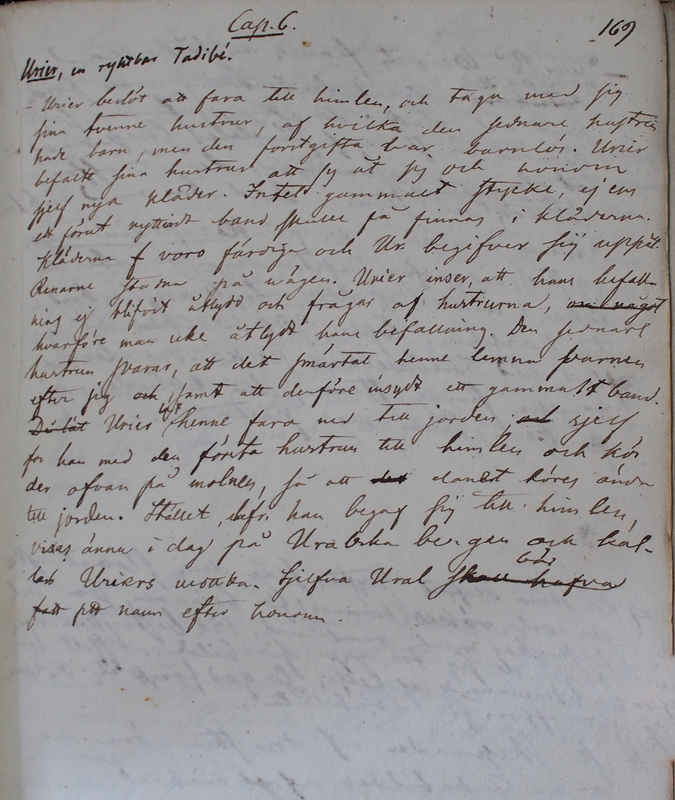Ethnographiska, historiska och statistiska anmärkningar. 169
Title
Description
| Cap. 6 Urier, en ryktbar Tadibé. Urier
beslöt att fara till himlen, och taga med sigAccording to the travelogue, Castrén noted the narrative down from a female TN тадебя he met while travelling by boat from Kolva to the east in 1843. He also related the narrative in his letter to Collan (Castrén 2019: 513–515), and it ended up in his published travelogue, too (1852: 243, 270–274). The tale is of interest for Castrén because of its mythic nature and because it relates to the living environment of the Nenets and its history. Lehtisalo noted down a similar narrative in Mezenʹ and in the lower Obʹ area (Lehtisalo 1924: 78, 139).
sina tvenne hustrur, af hvilka den sednare hustrun hade barn, men den förstgifta var barnlös. Urier befalte sina hustrur att sy åt sig och hvardera sjelf nya kläder. Intet gammalt stycke, ej ens ett förut nyttadt band skulle få finnas i kläderna. Kläderna voro färdiga och Ur[ier]. begifver sig uppåt. Renarne stadna på wägen. Urier inser, att hans befall- ning ej blifvit åtlydd och frågar af hustrurna, om något hvarföre man icke åtlydt hans befallning. Den sednare hustrun svarar, att det smärtat henne lemna barnen efter sig ock samt att derföre insydt ett gammalt band. Då lät Urier lat henne fara ned till jorden och; sjelf for han med den första hustrun till himlen och kör der ofvan på molnen, så att dånet höres ända till jorden. Stället defr.[derifrån] han begaf sig till himlen, visas ännu i dag på Uralska bergen och kallas Uriers шопка. Sjelfva Ural skall hafva bär fått sitt namn efter honom. |
Chapter VI Urier, a famous Tadibé.Urier decided to go to heaven and take his two wives with him. The second wife had children, but the one he had married first was childless. Urier commanded the wives to sew new clothes for himself and themselves. No old piece, not even a ribbon previously used, would be allowed to be in the clothes.The clothes were finished and Urier got up. The reindeer were standing ready. Urier realised that he had not been obeyed and asked the wives why they had not followed his orders. The second wife replied that it hurt her to leave the children and that she therefore sewed an old ribbon into the clothes. Urier let her go down to the earth and he himself went with his first wife to heaven and drove there over the clouds, so that the rumble was heard on the earth. From there he went to heaven, and even today he appears on the Ural Mountains and it is called Urier’s slope. The Urals themselves are named after him. |

